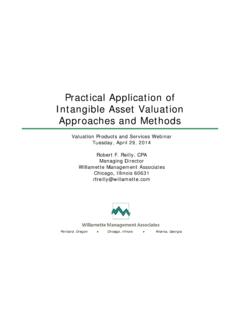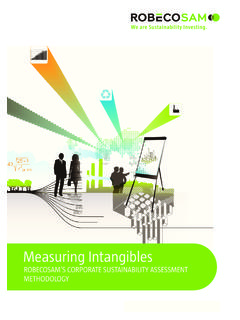Transcription of Illustrative Example of Intangible Asset Valuation - …
1 Illustrative Example of Intangible Asset Valuation Shockwave Corporation Working Party No. 6 s Special Session on the Transfer Pricing Aspects of intangibles Deloitte & Touche LLP and affiliated entities. THE CANADIAN INSTITUTE OF CHARTERED BUSINESS VALUATORS Foreward 2 OECD TP WP6: Illustrative Example of Intangible Asset Valuation This presentation contains general information only and none of Deloitte Touche Tohmatsu, its member firms, or affiliates ( Deloitte ), by means of this presentation or its publication, rendering accounting, business, financial, tax, legal, investment or other professional advice or service. The opinion expressed within this presentation are my own and do not necessarily represent positions, strategies or opinions of Deloitte, nor The Canadian Institute of Chartered Business Valuators. This is not an official presentation from Deloitte. The presentation is for general information purposes only and should not be considered as a substitute for professional advice and counsel.
2 Deloitte & Touche LLP and affiliated entities. Introduction Intangible Asset Valuation 3 Deloitte & Touche LLP and affiliated entities. THE CANADIAN INSTITUTE OF CHARTERED BUSINESS VALUATORS Overview Methodology Recap Illustrative Example Conclusion Introduction 4 OECD TP WP6: Illustrative Example of Intangible Asset Valuation process Recap: Reflief from Royalty Excess Earnings Cost Greenfield With or Without Example Shockwave Case Study Tradenames Content Workforce License Customers Technology Weighted Average Return on Assets Deloitte & Touche LLP and affiliated entities. THE CANADIAN INSTITUTE OF CHARTERED BUSINESS VALUATORS Valuation Process Methodology Recap Illustrative Example Conclusion Introduction 5 OECD TP WP6: Illustrative Example of Intangible Asset Valuation Step 1 Step 2 Step 3 Step 4 Step 5 Step 6 Step 7 Purpose Scoping Identification Diligence Analysis Reasonableness Value Conclusion Valuation Project Planning Deloitte & Touche LLP and affiliated entities.
3 Methodology Recap Intangible Asset Valuation 6 Deloitte & Touche LLP and affiliated entities. THE CANADIAN INSTITUTE OF CHARTERED BUSINESS VALUATORS Relief from Royalty Description Frequent Applications Key Inputs Diligence Matters Revenues that are not attributable to the Intangible ( non-brand product revenues) Length of economic benefit of the Asset Appropriateness of observable comparables used to derive a notional royalty rate Risk premiums included in the discount rate t FV = PV(r) t=0 Revenue x Royalty (1 tax) 1 2 3 4 Methodology Recap Illustrative Example Conclusion Introduction Determines value by reference to the hypothetical royalty payments that would be saved through owning the Asset , as compared with licensing the Asset from a third party. Brand (most common); Technology; and, Know-how. Revenue forecast associated with the Intangible Asset being valued Expected life of the Intangible Notional royalty rate applicable to the Intangible Discount rate 1 2 3 4 7 OECD TP WP6: Illustrative Example of Intangible Asset Valuation Deloitte & Touche LLP and affiliated entities.
4 THE CANADIAN INSTITUTE OF CHARTERED BUSINESS VALUATORS Excess Earnings Description Frequent Applications Key Inputs Diligence Matters Revenue migration/attrition rate Expenses saved or to be excluded from the earnings attributable to the Asset ( S&M) Valuation /selection of the contributory assets and the rates of return used in calculation Consistency of expenses and CAC s Risk premiums included in the discount rate t FV = PV(r) t=0 Revenue Expenses CAC s Taxes 1 2 3 4 The present value of the earnings attributable to the subject Intangible Asset after providing for the proportion of the earnings that attribute to returns for contributory assets. In order to determine a fair return on and/or of these contributory assets, their value must be capable of being determined in priority. Customer relationships Vendor relationships Technology Applicable revenue forecast Applicable expenses Contributory Asset charges ( CAC ) Expected future tax rates Expected life Discount rate Tax amortization benefit ( Asset values, tax rates, tax amortization rates) 1 2 3 4 5 6 6 5 IPR&D Order backlog Licenses 8 OECD TP WP6: Illustrative Example of Intangible Asset Valuation Methodology Recap Illustrative Example Conclusion Introduction 7 PV(r) + Tax Benefit 7 Deloitte & Touche LLP and affiliated entities.
5 THE CANADIAN INSTITUTE OF CHARTERED BUSINESS VALUATORS Cost Description Frequent Applications Key Inputs Diligence Matters Inclusion/exclusion of any overhead costs and the allocation rate used; Inclusion of opportunity costs; Functional, economic, and technological adjustment factor assumptions Inclusion of taxes or tax shield Replacement Cost New Obsolescence Factors 1 Estimates the fair value of an Asset by approximating its depreciated replacement cost, which would include all costs necessary to construct a similar Asset of equivalent utility at prices applicable at the time of reconstruction. The cost approach is based on the premise that a prudent third-party purchaser would pay no more for an Asset than its replacement cost. All hypothetical costs that are needed to recreate the Asset including materials and labour 1 Licenses and permits; Certifications; Internally-generated software; and Workforce.
6 9 OECD TP WP6: Illustrative Example of Intangible Asset Valuation Methodology Recap Illustrative Example Conclusion Introduction Adjustment factors to reduce the replacement cost to the functional, economic, and technological condition of the subject Asset 2 2 Deloitte & Touche LLP and affiliated entities. THE CANADIAN INSTITUTE OF CHARTERED BUSINESS VALUATORS With or Without Description Frequent Applications Key Inputs Diligence Matters Identification of incremental income Length of recreation period and pattern of ramp-up Assumption around competition and market share Cost of recreation Incremental risk to business cost of capital excluding Asset t FV = PV1(r) t=0 Revenue Expenses CapEx/WC Taxes 1 2 3 4 Non-competition agreements; Franchises; and Processes and technologies. Free cash flow forecast for business with Asset Enterprise-wide discount rate Expected life of business Free cash flow forecast excluding subject Asset Enterprise-wide discount rate excluding Asset Expected period to replace Asset + costs Tax amortization benefit ( Asset values, tax rates, tax amortization rates) 1 2 3 4 5 6 6 5 t PV2(r) t=0 Revenue Expenses CapEx/WC Taxes PV3(r) + Tax Benefit Estimates the fair value of an Asset by comparing the value of the business inclusive of the Asset , to the hypothetical value of the same business excluding the Asset .
7 7 7 10 OECD TP WP6: Illustrative Example of Intangible Asset Valuation Methodology Recap Illustrative Example Conclusion Introduction Deloitte & Touche LLP and affiliated entities. THE CANADIAN INSTITUTE OF CHARTERED BUSINESS VALUATORS Greenfield Description Application Key Inputs Diligence Matters Support for start-up levels of income and capital costs Support for length and pattern of ramp-up Assumption around competition and market share Incremental risk premiums in discount rate to reflect start-up nature of cashflows t FV = PV(r) t=0 1 3 2 Non primary income generating assets Licenses and permits; Rights ( Water, cutting, mining) Franchise agreements Start-up cashflow forecast, including capital costs Expected ramp-up period and pattern Start-up-type discount rate Tax amortization benefit ( Asset values, tax rates, tax amortization rates) 1 2 3 4 PV(r) + Tax Benefit Estimates the value of the Asset based on the discounted cashflows of a notional start-up business with no assets but the subject Intangible .
8 4 11 OECD TP WP6: Illustrative Example of Intangible Asset Valuation Methodology Recap Illustrative Example Conclusion Introduction Revenue Expenses CapEx/WC Taxes Deloitte & Touche LLP and affiliated entities. THE CANADIAN INSTITUTE OF CHARTERED BUSINESS VALUATORS > WACC > cost of equity > returns on other assets Cost of equity In between rates for tangible Asset backing and goodwill Lease rates Mortgage rates Asset -backed lending rates Goodwill Intangible Assets Fixed assets Equity Working Capital Discount rate considerations Debt WACC WARA Discount rate Considerations Short-term borrowing rate 12 OECD TP WP6: Illustrative Example of Intangible Asset Valuation Methodology Recap Illustrative Example Conclusion Introduction Risk Reward ENTERPRISE VALUE Illustrative Example Shockwave Corporation 13 THE CANADIAN INSTITUTE OF CHARTERED BUSINESS VALUATORS Shockwave Corporation: Business Overview Business Overview Shockwave Corporation is Canada s largest satellite radio provider.
9 Shockwave commenced operations five years ago when the Canadian government granted satellite spectrum licenses to four Canadian start-ups seeking to cultivate a then burgeoning industry for Canada. Since that time, precipitated by the accelerating wireless data needs of telecommunication industry technology, the government has stated that it will not be licensing any new spectrum for satellite radio, but may approve the sale or transfer of existing spectrum. Shockwave generates its revenue from monthly subscriptions to consumers sourced via a direct retail sales channel ( direct mail, print and television advertisements, billboards, and retail in-store kiosks). Shockwave does not manufacture the satellite radio receivers used by consumers, but transmits signals that can be received by a unit once the unit is registered/activated as an Shockwave unit. After five years of research and development activities, Shockwave developed a proprietary software technology for the transmission of on-demand radio content.
10 As a result, Shockwave created six new on-demand premium subscription stations exclusively broadcasting educational programs covering Parenting, Finance, History, Motivational topics, Biographies, and Cooking. This premium service is only offered to customers that are on a regular subscription , and are not available separately. The success of this novel business was immediate, generating incremental revenues of approximately $45 million last year. Most of Shockwave s regular music and talk radio content is acquired from third-party sources, based on normal recording industry royalty-based pay scales. However, for the exclusive broadcast on its premium on-demand channels, Shockwave produced an archive of over 1,000 twenty- to sixty-minute proprietary programs protected by copyright created via internal publishers and third-party consultants ( doctors, professors, and professionals).














